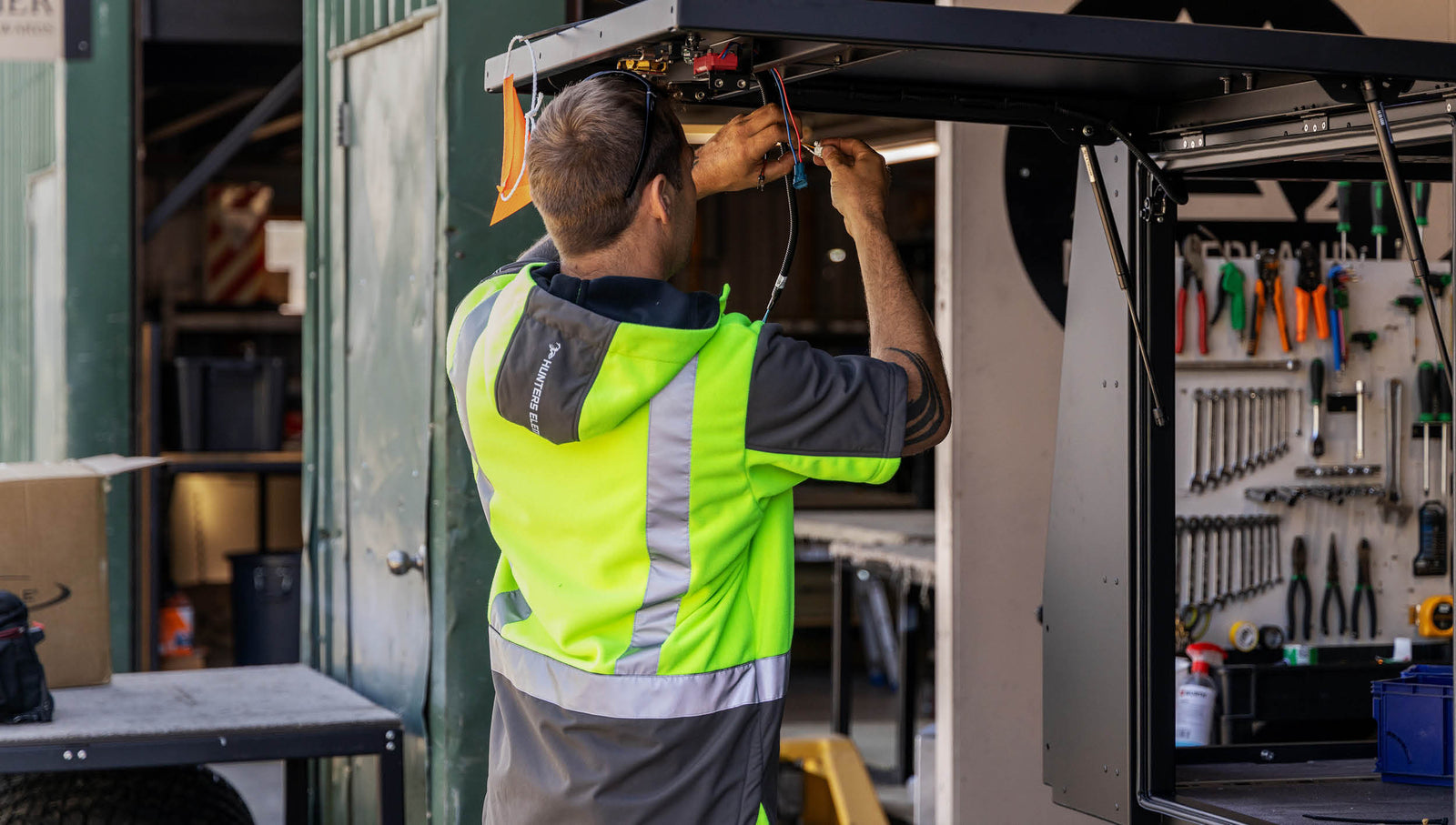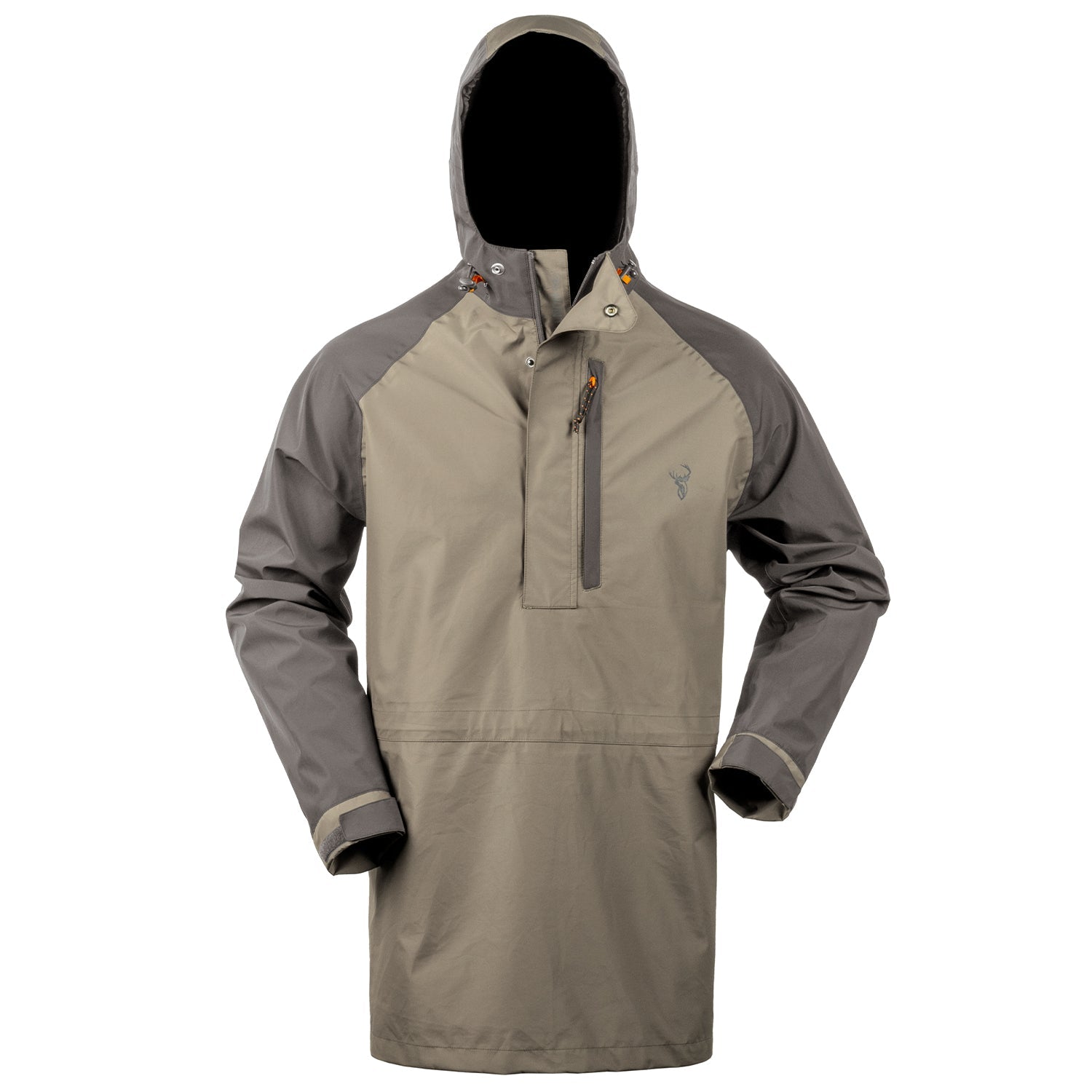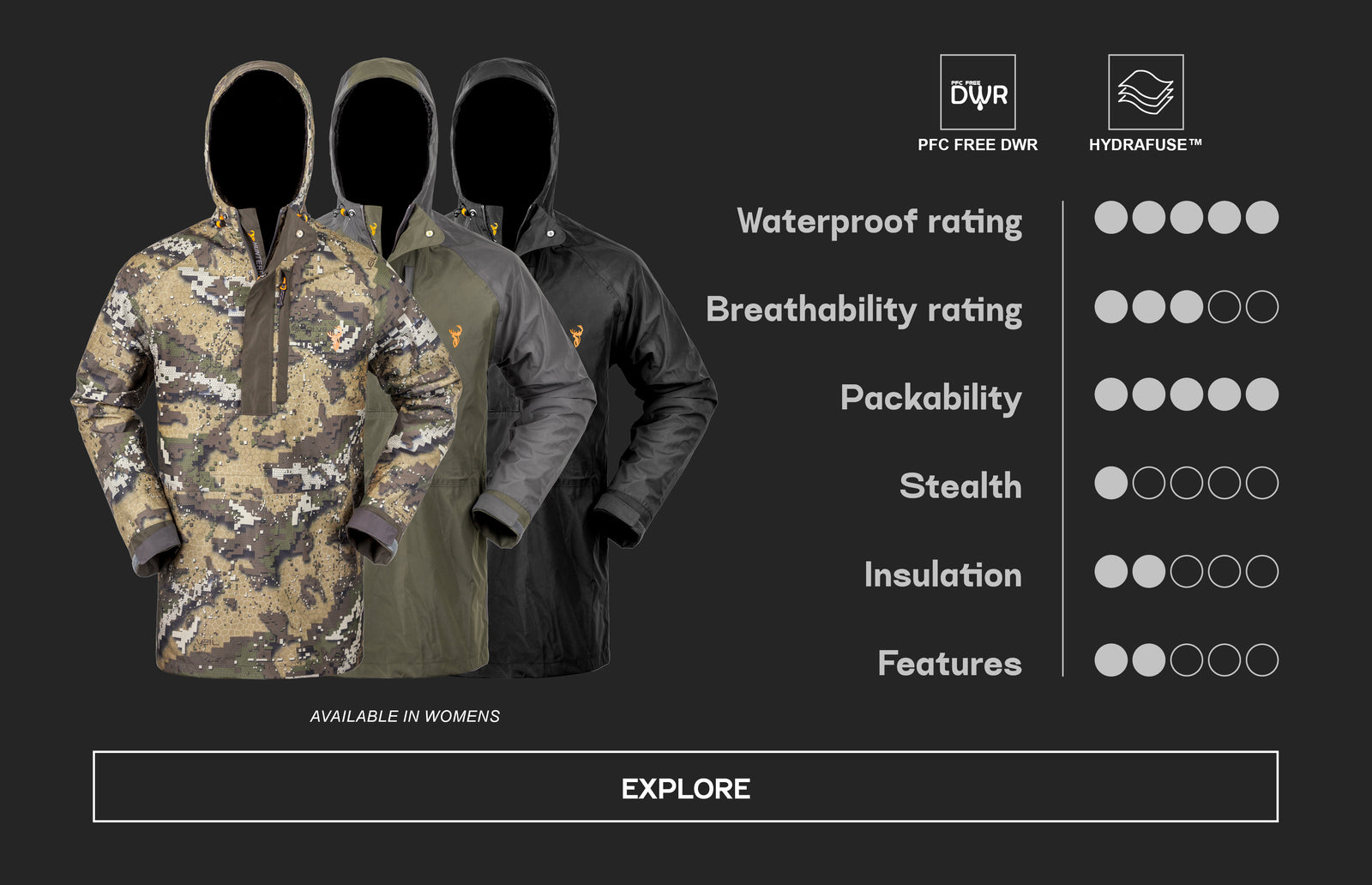As you embark on your outdoor adventures, it's crucial to equip yourself with the right gear, and our range of hunting jackets are designed to meet diverse challenges while ensuring your comfort and safety.
Our range of barrier layers all serve two key functions; 1. Block out all nasty rain, blood and snow, and 2. Expel the uncomfortable moisture build up. From there, things get a bit more complicated. Different hunts and hikes have unique requirements, such as maximising durability, stealth, packability, or insulation.
Here our comprehensive guide will point you in the right direction, so you know exactly which waterproof jacket, suits your needs. You'll confidently stride into the great outdoors, prepared for whatever nature throws your way.
DELUGE JACKET
Hunt, work, farm - the toughest jacket ever. Built tough from reinforced, recycled nylon, it’s been meticulously designed for extreme durability, comfort in the roughest of conditions, and day-in, day-out performance, from the farmyard to the mountain hunt.
Odyssey Jacket V2
The ultimate all-rounder that performs from the forest floor up to the mountain tops and stands up to a bashing. Created for the hardcore hunter who needs a reliable hunting barrier layer for all the manner of conditions and terrains. The Odyssey V2 hunting jacket combines waterproofing and breathability with a quiet outer fabric for those close quarters bush stalking.
Atlas Jacket
Created in the lab, verified in the Alps. The Alpine environment demands ultra-light and ultra-breathable in place of all-around balance. The Atlas is a technology-driven, specialised product. This series was created for the mountains, where durability, water-shedding and packability must be prioritised over stealth.
Sleet Jacket
A waterproof puffer jacket ruthlessly designed to be hardcore 2 in 1 that excels in both categories. The construction starts with a 2-layer waterproof/breathable outer, filled with 100gm Primaloft® Gold synthetic down to retain insulation properties even if wet.
Downpour Elite Jacket
The Downpour Elite jacket is a do-it-all, workhorse, waterproof & breathable hunting jacket. The quiet outer fabric and two large billowed lower pockets lend themselves to duck shooting as well as deerstalking. It looks good, it's quiet, it breathes, it has plenty of features and most importantly it is super waterproof.
Storm Jacket
The Storm jacket packs down incredibly small and weighs next to nothing, so you will barely notice it sitting in the bottom of your pack. But when it is needed, it's extremely waterproof and breathable, with a full-length zip to easily slip on and off.
Halo Jacket
The Halo jacket offers an ultra-light choice for extreme weather. Designed to be super packable for when the weather takes an unexpected turn. Unlike a lot of backup style rainwear, the Halo was designed with all the key features including a longer cut, athletic shape, sculpted hood and many more.
WATERPROOF JACKETS FAQS
-
Both the Storm Jacket and the Halo Jacket are ultra-light, super waterproof jackets designed to pack down small in case the weather takes a turn.
The Storm Jacket has a full-length zip and two hip pockets. The Halo Jacket has a ½ length zip with one chest pocket, and it can pack away into this pocket. Due to the longer zip, the Storm Jacket is very slightly heavier.
Both are fully seam-sealed with the same waterproof and breathability ratings (25,000mm waterproof rating and 10,000gm/m2/24hrs breathability rating).
-
The Downpour Elite is a jack of all trades and is stealthy, ideal for bush stalking. It is well suited to waterfowl hunting as it’s shorter (so it won't get in the way when you’re sitting and wading) and the deep bellowed lower pockets are ideal for dumping ammo.
The Odyssey V2 is a premium all-rounder, with cutting-edge features that really set it apart from the Downpour Elite. It performs from the forest floor up to the mountain tops and is also quiet for close-quarters bush stalking.
Both have the same waterproof rating (22,000mm). The Odyssey V2 has a slightly higher breathability rating (15,000gm/m2/24hrs versus the Downpour Elite which has 10,000gm/m2/24hrs).
-
PFC DWR stands for Perfluorinated Compound Free Durable Water Repellent.
Perfluorinated Compound (PFC) are chemicals commonly used in waterproof outdoor apparel as well as many more common household items such as nonstick cookware and paints. We aren’t fans of the by-products that come from using these chemicals and their impact on the environment.
All DWR used in the Hunters Element range is PFC free, and you can read more about our choice to use this type of PFC free DWR here.
-
We use Japanese Industrial Standards (JIS) waterproof testing on our range.
JIS testing involves a specific machine that simulates Hydrostatic head testing. It uses pressure and water to see how resistant a fabric is to water ingress. A piece of our fabric is clamped and sealed in the test rig, water pressure is gradually increased against the outer face of the fabric until the fabric begins to fail and leaks appear.
The pressure is measured and recorded at this point. PSI, KG/cm2 and MM (Hydrostatic Head) are all units of pressure that these machines can typically produce.
Fabric is considered waterproof if it can withstand over 2,000mm. The average pressure of rainfall is between 1,000 – 2,000mm. Here is how our range performs in the JIS waterproofing tests:
Atlas Jacket – 30,000mm
Storm Jacket – 25,000mm
Halo Jacket – 25,000mm
Sleet Jacket – 25,000mm
Odyssey V2 Jacket – 22,000mm
Downpour Elite Jacket – 22,000mm
Our jackets are constructed with a 3-layer waterproof and breathability system, and are specially designed to be very waterproof while remaining breathable through the use of technologically advanced membranes.
-
Our waterproof jackets are also made breathable through a second-generation style of construction, where three layers of fabric are bonded together:
- The outside face fabric which is strong and quiet, and treated with a PFC-free durable water repellent.
- The middle membrane, which wicks away sweat from your body with its hydrophilic properties (meaning, it loves water).
- The inside layer which is a fine tricot mesh that sits against your body, providing comfort for you and protection for your jacket against high-friction areas.
The middle membrane’s hydrophilic properties effectively wicks sweat and moisture off your body, and this moisture then beads, and evaporates up through the outer layer fabric – driven by the difference in temperature and air pressure between the inside of the jacket, and the outside world.
As this middle membrane loves moisture, it is important to ensure the outside layer has its DWR maintained over the life of the jacket, so the moisture continues to effectively move (and stay) from the inside to the outside.
The breathability testing expresses results in number of grams of moisture that is wicked and evaporated through one square metre of fabric, in 24 hours. The higher the number, the better the breathability. A rating of 8,000g/m2/24hrs is considered a good breathability rating for outdoor use.
Here’s how our range stacks up:
Atlas Jacket – 40,000gm/m2/24hrs
Odyssey V2 Jacket – 15,000gm/m2/24hrs
Downpour Elite Jacket – 10,000gm/m2/24hrs
Storm Jacket - 10,000gm/m2/24hrs
Halo Jacket – 10,000gm/m2/24hrs
-
Both the Odyssey V2 and the Downpour Elite jackets are quiet and suited for close-quarter bush stalking.
-
Our base layers, mid-layers and outer layers are designed to be paired with each other – so the sizing has been graded to accommodate that. We recommend buying your usual top size when choosing your waterproof jacket.
-
Durable water repellent coatings, even when not used often, wear off over time. This can be noticed when water stops beading off the outer fabric. To reapply the DWR and get the waterproofing back to new, wash it in a sports wash or DWR replenish wash. Alternatively, a DWR spray will replenish the water repellence. We like the Grangers or Nikwax range for this.
-
When you've got towash all the blood and guts off your jacket, we recommend washing by hand, in a bathtub, in cold water using a Sportswash. Rinse thoroughly and allow to air dry. No not dry clean. Avoid using power detergents, or any other detergent which is scented or has UV brighteners.
-
We all know the power of a deer’s nose. However, they also have the ability to detect UV in clothing which stands out similarly to how humans see blaze orange.
-
The Hunters Element range is based on a 3-layer system: base layer, mid-layer and outer layer. These outer layers are designed to be worn above our base-layers (such as the Core or Core+ range) and our mid-layer range (such as the Legacy Jacket, Zenith top or Whakarapu Hood).
The outer layer is the final barrier of defence between you and Mother Nature, and is engineered for superior water resistance, breathability and noise reduction.
All three layers used together ensure you warm up, cool down and stay dry for superior performance in the field. The fabric technology in each layer has been thoughtfully designed to best regulate your temperature, breathe out excess heat and sweat, and keep you protected from the harsh elements.
























